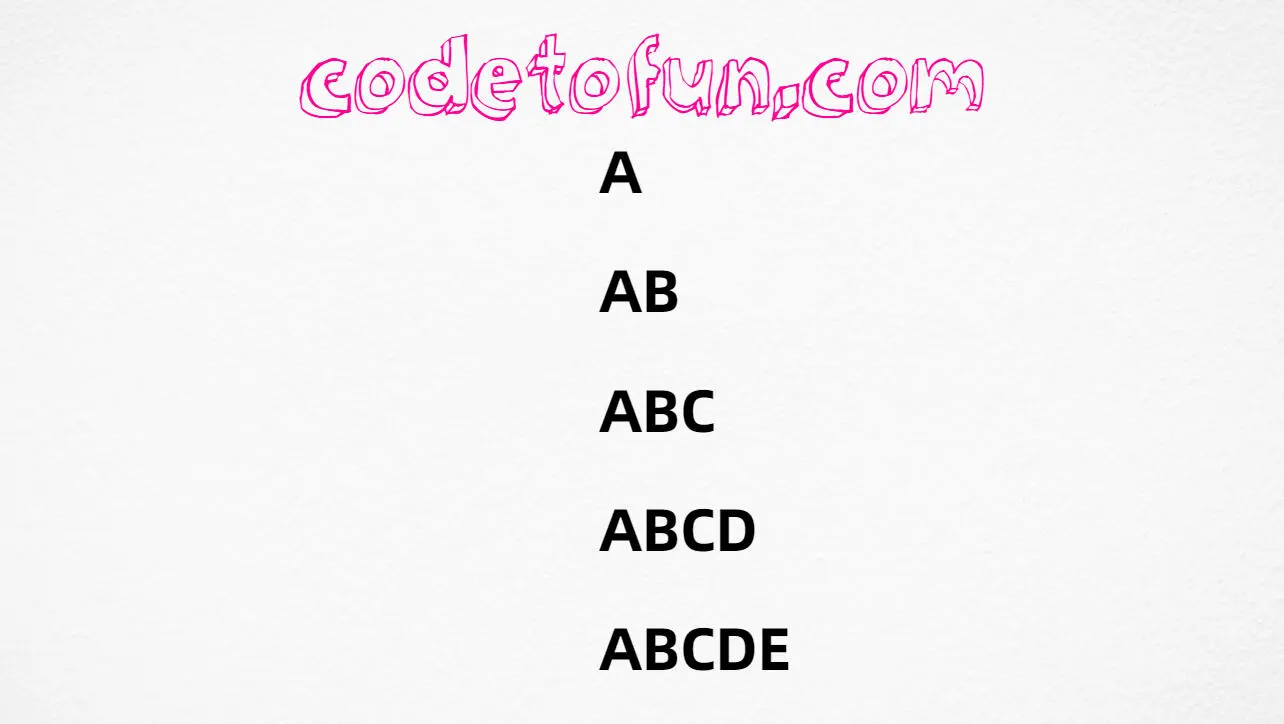
C Topics
- C Intro
- C Control Statement
- C Control Loops
- C String Functions
- C Math Functions
- C Header Files
- C Interview Programs
- C Star Pattern
- C Number Pattern
- C Alphabet Pattern
- Alphabet Pattern 1
- Alphabet Pattern 2
- Alphabet Pattern 3
- Alphabet Pattern 4
- Alphabet Pattern 5
- Alphabet Pattern 6
- Alphabet Pattern 7
- Alphabet Pattern 8
- Alphabet Pattern 9
- Alphabet Pattern 10
- Alphabet Pattern 11
- Alphabet Pattern 12
- Alphabet Pattern 13
- Alphabet Pattern 14
- Alphabet Pattern 15
- Alphabet Pattern 16
- Alphabet Pattern 17
- Alphabet Pattern 18
- Alphabet Pattern 19
- Alphabet Pattern 20
- Alphabet Pattern 21
- Alphabet Pattern 22
- Alphabet Pattern 23
- Alphabet Pattern 24
- Alphabet Pattern 25
- Alphabet Pattern 26
- Alphabet Pattern 27
- Alphabet Pattern 28
- Alphabet Pattern 29
- Alphabet Pattern 30
- Alphabet Pattern 31
- Alphabet Pattern 32
- Alphabet Pattern 33
- Alphabet Pattern 34
C Alphabet Pattern 1

Photo Credit to CodeToFun
C Alphabet Pattern 1
Here`s a program that prints the above alphabet pattern using C Programming:
#include <stdio.h>
int main() {
int i, j;
char ch = 'A';
for (i = 1; i <= 5; i++) {
for (j = 1; j <= i; j++) {
printf("%c", ch++);
}
printf("\n");
ch = 'A';
}
return 0;
}💻 Testing the Program
When you run the above program, it will print the following output:
A AB ABC ABCD ABCDE
🧠 How the Program Works
Let's break down the logic behind the code:
- The program starts by including the necessary header file, stdio.h, to enable input/output operations.
- The program declares variables: i and j as loop counters, and ch to represent the character to be printed.
- The character ch is initially set to 'A'.
- The program uses a nested for loop to print the pattern.
- The outer loop, i, iterates from 1 to 5, representing the number of rows in the pattern.
- The inner loop, j, iterates from 1 to the current value of i, representing the number of characters to be printed in each row.
- Inside the inner loop, the program prints the character ch using printf("%c", ch++).
- The "%c" format specifier is used to print a character.
- After printing the character, ch is incremented to the next character using ch++.
- After each row is printed, a newline character (\n) is printed using printf("\n") to move to the next line.
- After printing each row, ch is reset to 'A' to start again from the beginning of the alphabet.
- This process is repeated for each value of i in the outer loop, resulting in the pattern being printed.
- The program terminates by returning 0.
In this pattern, each line starts with the letter 'A' and gradually adds one more letter from the alphabet in each subsequent line. The number of letters in each line corresponds to the line number.
💯 Tips for Enhancement:
Explore the versatility of this pattern by adjusting its parameters. Whether you increase or decrease the size, tweak the spacing, or modify the characters used, each change opens up a world of possibilities, allowing you to customize and create your unique visual effects.
✔ Conclusion:
Creating visually appealing patterns is not only a fun endeavour but also a great way to enhance your programming or design skills. We hope this tutorial has inspired you to explore the world of creative coding. Share your creations with us, and let your imagination run wild!
🤗 Closing Call-to-Action:
We'd love to see your unique interpretations of the alphabet pattern. Share your creations in the comments below, and don't hesitate to reach out if you have any questions or suggestions for future tutorials. Happy coding!
👨💻 Join our Community:
Author

For over eight years, I worked as a full-stack web developer. Now, I have chosen my profession as a full-time blogger at codetofun.com.
Buy me a coffee to make codetofun.com free for everyone.
Buy me a Coffee












If you have any doubts regarding this article (C Alphabet Pattern 1) please comment here. I will help you immediately.